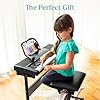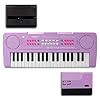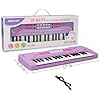Table of Contents
Introduction to Easy Piano Pieces for Beginners
Starting your musical journey with the piano can be exhilarating yet intimidating. Choosing the right repertoire is crucial to foster initial interest and assure continual progress. This guide focuses on helping beginners find piano pieces that are not only engaging and enjoyable, but also suited to develop fundamental skills without overwhelming the learner. Discover a curated list of some of the easiest piano pieces to begin your education, ensuring a positive and motivating start to your piano-playing adventure.
1. “Twinkle, Twinkle, Little Star”
This classic children’s song is often one of the first pieces beginner pianists learn. Its simple melody and repetitive pattern make it easy to memorize. The tune also helps in getting familiar with basic finger positioning and movement on the piano.
Best Choice Products 61-Key Electronic Keyboard Piano Portable Electric Keyboard Complete Beginner Set w/LED Screen, Stand, Bench, Headphones - Black
13% OffRockJam 61 Key Keyboard Piano Stand With Pitch Bend Kit, Piano Bench, Headphones, Simply Piano App & Keynote Stickers
$129.99 (as of December 20, 2025 13:23 GMT -08:00 - More infoProduct prices and availability are accurate as of the date/time indicated and are subject to change. Any price and availability information displayed on [relevant Amazon Site(s), as applicable] at the time of purchase will apply to the purchase of this product.)Piano Star
$0.00 (as of December 20, 2025 13:23 GMT -08:00 - More infoProduct prices and availability are accurate as of the date/time indicated and are subject to change. Any price and availability information displayed on [relevant Amazon Site(s), as applicable] at the time of purchase will apply to the purchase of this product.)Keyboard Piano for Kids, BIGFUN 37 Keys Toddler Piano Multifunction Music Educational Instrument Toy, Electronic Kids Keyboard for 3-7 Year Old Girls and Boys (Purple)
15% Off2. “Ode to Joy” by Ludwig van Beethoven
An excerpt from Beethoven’s Ninth Symphony, “Ode to Joy” is a fantastic piece for beginners. The melody is joyful and recognizable, encouraging students to practice with enthusiasm. The rhythm is steady and the notes are straightforward, making it an excellent choice for building confidence.
3. “Chopsticks”
“Chopsticks” is a fun and simple piece where beginners play two-note chords that alternate up the scale. This piece helps teach coordination between the left and right hands while providing an amusing musical experience that is easily recognizable.
4. “Jingle Bells”
This popular Christmas song is a perfect addition to a beginner’s repertoire. The melody is lively and the rhythm is consistent, making it a great practice piece for developing timing and hand coordination. Plus, it’s a crowd-pleaser during the holiday season!
5. “Heart and Soul”
Known for its place in pop culture, “Heart and Soul” is often played in four-hand piano settings, making it an engaging duet for beginners. The left-hand parts are simple and repetitive, while the right-hand melody is catchy and easy to learn.
RockJam RJ761 61 Key Keyboard Piano with Keyboard Bench, Digital Piano Stool, Sustain Pedal, Headphones & Lessons
$159.85 (as of December 20, 2025 22:54 GMT -08:00 - More infoProduct prices and availability are accurate as of the date/time indicated and are subject to change. Any price and availability information displayed on [relevant Amazon Site(s), as applicable] at the time of purchase will apply to the purchase of this product.)Donner DDP-300 Digital Piano with 88 Graded Hammer Action Weighted Keys, Record, Bluetooth, 10 Voices, 4 Reverb, Speakers, Professional Full Fize Key Keyboard Electric Dark Rose
17% OffDonner DEP-20 Beginner Digital Piano 88 Key Full Size Weighted Keyboard, Portable Electric Piano with Furniture Stand, 3-Pedal Unit
15% OffYAMAHA P71 88-Key Weighted Action Digital Piano with Sustain Pedal and Power Supply (Amazon-Exclusive)
6% Off6. “Au Clair de la Lune”
This traditional French nursery rhyme has a gentle, flowing melody that is soothing to play. The simple structure and repetitive pattern make it a good exercise for finger control and musical phrasing, which are essential piano skills.
7. “Mary Had a Little Lamb”
Another classic nursery rhyme, “Mary Had a Little Lamb” is excellent for beginners due to its simple and repetitive structure. It helps students practice their note reading and hand positioning while playing a familiar tune.
8. “Happy Birthday”
An essential song to know, “Happy Birthday” is easy to learn and useful to play at gatherings. The melody is straightforward and doesn’t require complicated finger movements, making it accessible for beginners of all ages.
9. “Bach’s Minuet in G”
Although slightly more advanced, Bach’s Minuet in G from the Anna Magdalena Notebook is a rewarding piece for beginners ready for a modest challenge. The piece is structured and elegant, promoting good hand technique and musical expression.
10. “Candle in the Wind” by Elton John
Not as traditional as some other beginner pieces, Elton John’s “Candle in the Wind” offers a modern option. The song’s slow tempo and melodic structure allow beginners to practice emotional expression and dynamic control.
How to Simplify Complex Pieces for Easy Learning
One effective way to simplify a complex piece is to divide it into smaller, more manageable sections. Focus on learning a few measures at a time. This method will help you avoid feeling overwhelmed and enable you to concentrate on perfecting each part before moving to the next.
When a piece seems too challenging, practice each hand separately. This allows you to focus on the melody with the right hand and the harmony with the left hand. Once you feel comfortable, gradually start combining both hands together.
Play the piece at a slower tempo than written. This helps you to understand the structure and nuances of the music. Utilize a metronome to maintain a steady pace, gradually increasing the tempo as you become more confident.
Complex rhythms can be overwhelming for beginners. Simplify these rhythms by breaking them down into more familiar patterns or practicing them separately. Focus on mastering the simpler rhythms before attempting to play them within the context of the full piece.
Write finger numbers on the sheet music to guide your hands through tricky passages. This can reduce errors and make learning faster. Consistent finger placement is crucial for developing muscle memory.
Repetition is key to learning complex pieces. Practice challenging sections repeatedly until they become second nature. Break these sections into even smaller fragments if necessary for focused practice.
Understanding the structure of the piece can make it easier to learn. Look for repeating patterns, chord progressions, and scales. Analyzing the music in this way provides a better grasp of its overall architecture.
Technological aids like piano learning apps, online tutorials, and MIDI files can offer valuable support. These resources often provide step-by-step instructions and can slow down or isolate parts of the music for focused practice.
A practice journal helps track your progress and identify areas that need more work. Documenting your practice sessions keeps you organized and focused, making it easier to tackle complex pieces effectively.
If you’re struggling with a piece, don’t hesitate to seek advice from a piano teacher or an experienced player. Personalized guidance can provide new techniques and perspectives that you might not have considered.
Using Popular Songs to Practice Chord Changes
One effective method for beginner pianists to enhance their skill in transitioning between chords is by practicing with popular songs. This technique not only keeps the learning process enjoyable but also helps in understanding chord progressions in a real musical context. Here are a few well-chosen songs to get started:
While practicing these songs, focus on the smoothness and speed of your chord changes. Start slowly, use a metronome, and gradually increase the tempo as you get more comfortable. Remember, consistency is key in mastering piano chords.
Learning Easy Classical Pieces for Beginners
Starting to learn the piano can be exciting and a bit daunting. But, with the right selection of easy classical pieces, beginners can smoothly transition into the world of music. Here are some ideal classical compositions that are tailored for beginners:
“Twinkle, Twinkle, Little Star” by Wolfgang Amadeus Mozart
This famous melody, known to many from childhood, is actually based on a French melody “Ah! vous dirai-je, maman.” Mozart composed twelve variations of this melody. Learning this piece helps beginners understand basic fingering and improves their ability to play melodic sequences.
“Minuet in G Major” by Johann Sebastian Bach
Bach’s “Minuet in G Major” is part of his Notebook for Anna Magdalena Bach, which includes several pieces that are great for beginners. This piece introduces learners to the Baroque style, stressing on the importance of rhythm and timing in music.
“Ode to Joy” by Ludwig van Beethoven
The symphonic theme from Beethoven’s Ninth Symphony has been adapted for piano and serves as a wonderful introduction to Beethoven’s work. Playing “Ode to Joy” helps beginners in learning how to manage simple chords and develop an understanding of melodic structures.
“Prelude in C Major” by Johann Sebastian Bach
This piece from The Well-Tempered Clavier is notable for its rolling melody and harmonic progression. It’s an excellent example of counterpoint and its repetitive pattern is a good exercise for finger independence.
“The Sick Doll” by Pyotr Ilyich Tchaikovsky
Part of Tchaikovsky’s “Album for the Young,” this short piece emotes the image of a resting doll. It exposes learners to expressive playing and dynamics that are essential for conveying the mood of a piece.
“Für Elise” by Ludwig van Beethoven
Although slightly more challenging, “Für Elise” is one of the most recognized piano pieces that is often suggested for beginners who have learned the basics. It helps improve the pianist’s technique and introduces them to more complex rhythms and tempos.
MusicNotes
MusicNotes is an exceptional resource for finding simple piano sheet music. They offer a vast library of over 400,000 arrangements for every skill level. The website is very user-friendly and includes tools like play-along features and transposition options. They also provide mobile apps, making it easy to practice on the go. With regular updates, MusicNotes ensures that you can always find the latest easy piano pieces to start learning today.
IMSLP (International Music Score Library Project)
IMSLP is one of the most comprehensive online libraries for free public domain sheet music. It boasts a collection of over 500,000 scores. While primarily known for classical pieces, it offers a good selection of beginner-friendly music, including simplified arrangements. The site’s community-driven nature means there are always new contributions, giving you fresh material to practice.
8notes
8notes is an excellent site specifically for beginners. They offer a wide variety of easy-to-read sheet music across multiple genres including classical, pop, and jazz. The website includes helpful features like audio previews and tempo control to assist with learning. Additionally, 8notes provides free and low-cost sheet music, making it accessible for everyone.
Piano Street
Piano Street is another valuable resource for those seeking beginner piano pieces. The site offers a vast array of professional-quality sheet music, along with practice tips and forums for support. They even offer content from well-known instructors and access to online masterclasses. This combination makes it ideal for new pianists looking to improve their skills quickly.
Virtual Sheet Music
Virtual Sheet Music specializes in high-quality digital sheet music for all levels. They have a unique collection of easy piano pieces designed for beginners. Their subscription service offers unlimited downloads and includes interactive sheet music, which is incredibly useful for those just starting out. They also have a customer support team to help with any questions, making the learning process smoother.
MakingMusicFun.net
Ideal for young beginners, MakingMusicFun.net offers an array of easy and fun sheet music specifically tailored for children. The site features user-friendly navigation and a variety of educational resources, including theory lessons and interactive games. This makes it a go-to resource for young pianists and their parents looking to make the learning process enjoyable.
Sheet Music Plus
Sheet Music Plus is one of the largest online retailers for sheet music and offers a plethora of easy piano arrangements for beginners. Their extensive catalog covers various genres and skill levels, and they frequently run promotions that allow for cost-effective downloading. The site also includes customer reviews, which can help you choose the best pieces to start learning today.
Conclusion
To conclude, for beginners looking to start their piano journey effectively, simple and recognizable pieces are ideal. Choosing pieces like “Twinkle Twinkle Little Star”, “Ode to Joy”, and “Chopsticks” can provide a motivational boost due to their familiarity and manageable difficulty level. Starting with these pieces helps in building fundamental skills and confidence, enabling a smooth transition to more complex compositions. In sum, the right selection of the easiest piano pieces kicks off a learning trajectory that is both enjoyable and enriching.








































































